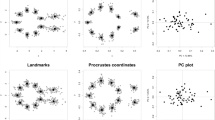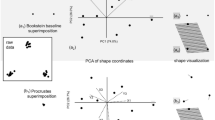Abstract
Manual landmark data collection on large samples takes a long time. Several options exist to speed the process, though each introduces problems or raises concerns of its own. For bilaterally symmetric structures (e.g., crania), some recent papers recommend limiting landmark collection to one side and the anatomical midline, then approximating the true bilateral configuration by merging the hemi-form and its reflection at the midline. However, where the midline is narrow relative to the bilateral anatomy, net midline landmark deviations from the mid-sagittal axis or plane will distort this “mirror-reflected” configuration. Here, I use a sample of bilaterally landmarked human mandibles to evaluate whether these distortions are a substantive concern at the scale of real biology. Through simulation, I introduce small mediolateral errors at the midline landmarks of the mean mandible form, then mirror-reflect one side in order to quantify and visualize the effect of midline error on mirror-reflected outcomes. I also test how faithfully mirror reflection and other reduced-landmarking strategies preserve shape and size relationships among observations characterized by the full, bilateral complement of landmarks. In both analyses, mirror reflection is shown to produce striking distortions. Mirror reflection is clearly inappropriate for these data and is likely suspect in all cases of narrow midline morphology. I also demonstrate that bilateral shape and size can be reasonably well recovered with a reflected-relabeling strategy where the landmark data consists of hemi-form landmarks plus a small number of landmarks from the specimen’s opposite side.









Similar content being viewed by others
Data Availability
Data is provided as Supplementary Material A to the manuscript.
Code Availability
Statistical code available by request to the author.
Notes
The wireframe links only the arch subset landmarks.
References
Adams, D., Collyer, M., & Sherratt, E. (2015). geomorph: Software for geometric morphometric analyses. R package version 2.1.6. https://cran.r-project.org/web/packages/geomorph/index.html.
Adler, D., Murdoch, D., & others. (2016). rgl: 3D visualization using OpenGL (Version 0.95.1441). https://CRAN.R-project.org/package=rgl
Benazzi, S., Fiorenza, L., Kozakowski, S., & Kullmer, O. (2011). Comparing 3D virtual methods for hemimandibular body reconstruction. The Anatomical Record,294(7), 1116–1125. https://doi.org/10.1002/ar.21410.
Bookstein, F. (1986). Size and shape spaces for landmark data in two dimensions. Statistical Science,1(2), 181–242.
Boyer, D. M., Lipman, Y., St Clair, E., Puente, J., Patel, B. A., Funkhouser, T., et al. (2011). Algorithms to automatically quantify the geometric similarity of anatomical surfaces. Proceedings of the National Academy of Sciences USA,108(45), 18221–18226. https://doi.org/10.1073/pnas.1112822108.
Bräuer, G., & Knußmann, R. (1988). Grundlagen der Osteometrie. In: Knußmann R (Ed.), Anthropologie. Handbuch der vergleichenden Biologie des Menschen. Band I, 1. Teil. (pp. 129–159). Stuttgart: Springer.
Cardini, A. (2016). Lost in the other half: Improving accuracy in geometric morphometric analyses of one side of bilaterally symmetric structures. Systematic Biology,65(6), 1096–1106. https://doi.org/10.1093/sysbio/syw043.
Cardini, A. (2017). Left, right or both? Estimating and improving accuracy of one-side-only geometric morphometric analyses of cranial variation. Journal of Zoological Systematics and Evolutionary Research,55(1), 1–10. https://doi.org/10.1111/jzs.12144.
Cardini, A., Diniz Filho, J., Polly, P., & Elton, S. (2010). Biogeographic analysis using geometric morphometrics: Clines in skull size and shape in a widespread African arboreal monkey. In A. M. Elewa (Ed.), Morphometrics for nonmorphometricians (pp. 191–217). New York: Springer.
Cardini, A., & Polly, P. D. (2013). Larger mammals have longer faces because of size-related constraints on skull form. Nature Communications,4, 2458. https://doi.org/10.1038/ncomms3458.
Claes, P., Roosenboom, J., White, J. D., Swigut, T., Sero, D., Li, J., et al. (2018). Genome-wide mapping of global-to-local genetic effects on human facial shape. Nature Genetics,50(3), 414–423. https://doi.org/10.1038/s41588-018-0057-4.
Cole, J. B., Manyama, M., Kimwaga, E., Mathayo, J., Larson, J. R., Liberton, D. K., et al. (2016). Genomewide association study of african children identifies association of SCHIP1 and PDE8A with facial size and shape. PLoS Genetics,12(8), e1006174. https://doi.org/10.1371/journal.pgen.1006174.
Cooke, S. B., & Terhune, C. E. (2015). Form, function, and geometric morphometrics. The Anatomical Record,298(1), 5–28. https://doi.org/10.1002/ar.23065.
Cooney, C. R., Bright, J. A., Capp, E. J. R., Chira, A. M., Hughes, E. C., Moody, C. J. A., et al. (2017). Mega-evolutionary dynamics of the adaptive radiation of birds. Nature,542(7641), 344–347. https://doi.org/10.1038/nature21074.
Dow, M. M., & Cheverud, J. M. (1985). Comparison of distance matrices in studies of population structure and genetic microdifferentiation: Quadratic assignment. American Journal of Physical Anthropology,68(3), 367–373. https://doi.org/10.1002/ajpa.1330680307.
Dryden, I. L. (2018). Shapes package (Version 1.2.4). Vienna, Austria: R Foundation for Statistical Computing.
Frost, S. R., Marcus, L. F., Bookstein, F. L., Reddy, D. P., & Delson, E. (2003). Cranial allometry, phylogeography, and systematics of large-bodied papionins (primates: Cercopithecinae) inferred from geometric morphometric analysis of landmark data. The Anatomical Record Part A: Discoveries in Molecular, Cellular, and Evolutionary Biology,275A(2), 1048–1072. https://doi.org/10.1002/ar.a.10112.
Gao, T., Yapuncich, G. S., Daubechies, I., Mukherjee, S., & Boyer, D. M. (2018). Development and assessment of fully automated and globally transitive geometric morphometric methods, with application to a biological comparative dataset with high interspecific variation. The Anatomical Record,301(4), 636–658. https://doi.org/10.1002/ar.23700.
Goswami, A., Watanabe, A., Felice, R. N., Bardua, C., Fabre, A. C., & Polly, P. D. (2019). High-density morphometric analysis of shape and integration: The good, the bad, and the not-really-a-problem. Integrative and Comparative Biology,59(3), 669–683. https://doi.org/10.1093/icb/icz120.
Gunz, P., & Mitteroecker, P. (2013). Semilandmarks: A method for quantifying curves and surfaces. Hystrix, the Italian Journal of Mammology,24(1), 103–109. https://doi.org/10.4404/hystrix-24.1-6292.
Gunz, P., Mitteroecker, P., Neubauer, S., Weber, G. W., & Bookstein, F. L. (2009). Principles for the virtual reconstruction of hominin crania. Journal of Human Evolution,57(1), 48–62. https://doi.org/10.1016/j.jhevol.2009.04.004.
Harvati, K. (2003). Quantitative analysis of Neanderthal temporal bone morphology using three-dimensional geometric morphometrics. American Journal of Physical Anthropology,120(4), 323–338. https://doi.org/10.1002/ajpa.10122.
Katz, D., & Friess, M. (2014). Technical note: 3D from standard digital photography of human crania—A preliminary assessment. American Journal of Physical Anthropology,154(1), 152–158.
Katz, D. C., Grote, M. N., & Weaver, T. D. (2017). Changes in human skull morphology across the agricultural transition are consistent with softer diets in preindustrial farming groups. Proceedings of the National Academy of Sciences USA,114(34), 9050–9055. https://doi.org/10.1073/pnas.1702586114.
Klingenberg, C. P. (2015). Analyzing fluctuating asymmetry with geometric morphometrics: Concepts, methods, and applications. Symmetry,7, 843–934.
Klingenberg, C. P., Barluenga, M., & Meyer, A. (2002). Shape analysis of symmetric structures: Quantifying variation among individuals and asymmetry. Evolution,56(10), 1909–1920.
Li, M., Cole, J. B., Manyama, M., Larson, J. R., Liberton, D. K., Riccardi, S. L., et al. (2017). Rapid automated landmarking for morphometric analysis of three-dimensional facial scans. Journal of Anatomy,230(4), 607–618. https://doi.org/10.1111/joa.12576.
Maga, A. M., Tustison, N. J., & Avants, B. B. (2017). A population level atlas of Mus musculus craniofacial skeleton and automated image-based shape analysis. Journal of Anatomy,231(3), 433–443. https://doi.org/10.1111/joa.12645.
Mantel, N. (1967). The detection of disease clustering and a generalized regression approach. Cancer Research, 27(1), 209–220.
Marcus, L. F., Bello, E., & Garcia-Valdecasas, A. (1992). Contributions to morphometrics. Madrid, Spain: Consejo Superior de Investigaciones Cientificas.
Mardia, K. V., Bookstein, F. L., & Moreton, I. J. (2000). Statistical assessment of bilateral symmetry of shapes. Biometrika,87(2), 285–300.
Mitteroecker, P. (2018). Semilandmarks in biology. In MORPHMET. https://groups.google.com/a/morphometrics.org/forum/#!forum/morphmet.
Mitteroecker, P., & Bookstein, F. (2011). Linear discrimination, ordination, and the visualization of selection gradients in modern morphometrics. Evolutionary Biology,38(1), 100–114.
Mitteroecker, P., & Gunz, P. (2009). Advances in geometric morphometrics. Evolutionary Biology,36(2), 235–247. https://doi.org/10.1007/s11692-009-9055-x.
Nicholson, E., & Harvati, K. (2006). Quantitative analysis of human mandibular shape using three-dimensional geometric morphometrics. American Journal of Physical Anthropology,131(3), 368–383. https://doi.org/10.1002/ajpa.20425.
Pavličev, M., Mitteroecker, P., Gonzalez, P. M., Rolian, C., Jamniczky, H., Villena, F. P., et al. (2016). Development shapes a consistent inbreeding effect in mouse crania of different line crosses. Journal of Experimental Zoology Part B - Molecular and Developmental Evolution,326(8), 474–488. https://doi.org/10.1002/jez.b.22722.
Percival, C. P., Devine, J., Darwin, B. C., Liu, W., van Eede, M., Henkelman, R. M., & Hallgrímsson, B. (2019). The effect of automated landmark identification on morphometric analysis. Journal of Anatomy, 234, 917–935. https://doi.org/10.1111/joa.12973.
R Core Team. (2019). R: A language and environment for statistical computing. R Foundation for Statistical Computing, Vienna, Austria. https://www.R-project.org/.
Rohlf, F. J. (2000). Statistical power comparisons among alternative morphometric methods. American Journal of Physical Anthropology,111, 463–478.
Rohlf, F.J., & Bookstein, F. (Eds.). (1988). Proceedings of the Michigan morphometrics workshop (Vol. 2). Ann Arbor, MI: University of Michigan Museum of Zoology.
Rohlf, F. J., & Marcus, L. F. (1993). A revolution in morphometrics. Trends in Ecology and Evolution,8(4), 129–132. https://doi.org/10.1016/0169-5347(93)90024-j.
Rohlf, F. J., & Slice, D. E. (1990). Extensions of the Procrustes method for the optimal superimposition of landmarks. Systematic Zoology,39(1), 40–59.
Savriama, Y., & Klingenberg, C. P. (2011). Beyond bilateral symmetry: Geometric morphometric methods for any type of symmetry. BMC Evolutionary Biology,11(1), 280.
Slice, D. E. (2005). Modern morphometrics. In D. E. Slice (Ed.), Modern morphometrics in physical anthropology (pp. 1–45). New York: Kluwer Acad./Plenum.
Slice, D. E. (2007). Geometric morphometrics. Annual Review of Anthropology,36, 261–281.
Watanabe, A. (2018). How many landmarks are enough to characterize shape and size variation? PLoS ONE,13(6), e0198341. https://doi.org/10.1371/journal.pone.0198341.
Zelditch, M. L., Swiderski, D. L., & Sheets, H. D. (2014). Geometric morphometrics for biologists: A primer (2nd ed.). New York: Elsevier Academic Press.
Acknowledgements
The author thanks Timothy D. Weaver and the members of the Hallgrímsson lab for comments on an early version of this manuscript.
Funding
None for this project.
Author information
Authors and Affiliations
Corresponding author
Ethics declarations
Conflict of interest
The author has no conflicts of interest.
Electronic supplementary material
Below is the link to the electronic supplementary material.
Rights and permissions
About this article
Cite this article
Katz, D.C. The Occasional Perils of Reflection (Across the Midline; in Geometric Morphometrics). Evol Biol 47, 164–174 (2020). https://doi.org/10.1007/s11692-020-09501-1
Received:
Accepted:
Published:
Issue Date:
DOI: https://doi.org/10.1007/s11692-020-09501-1




